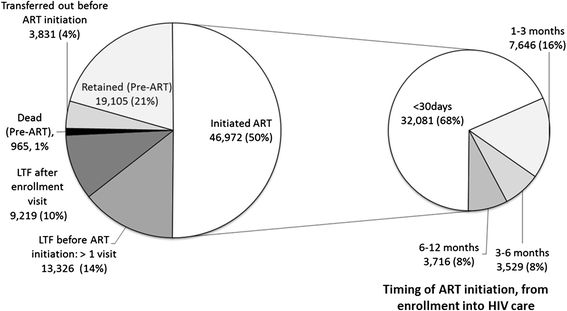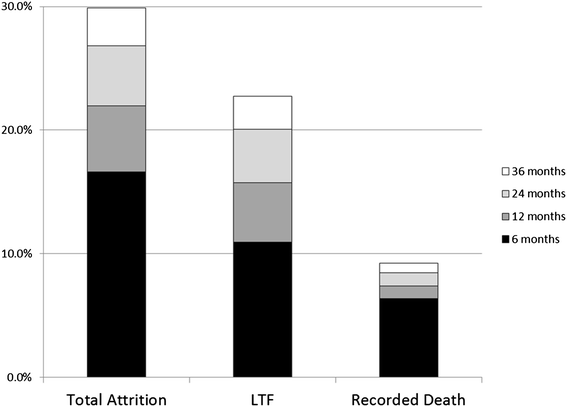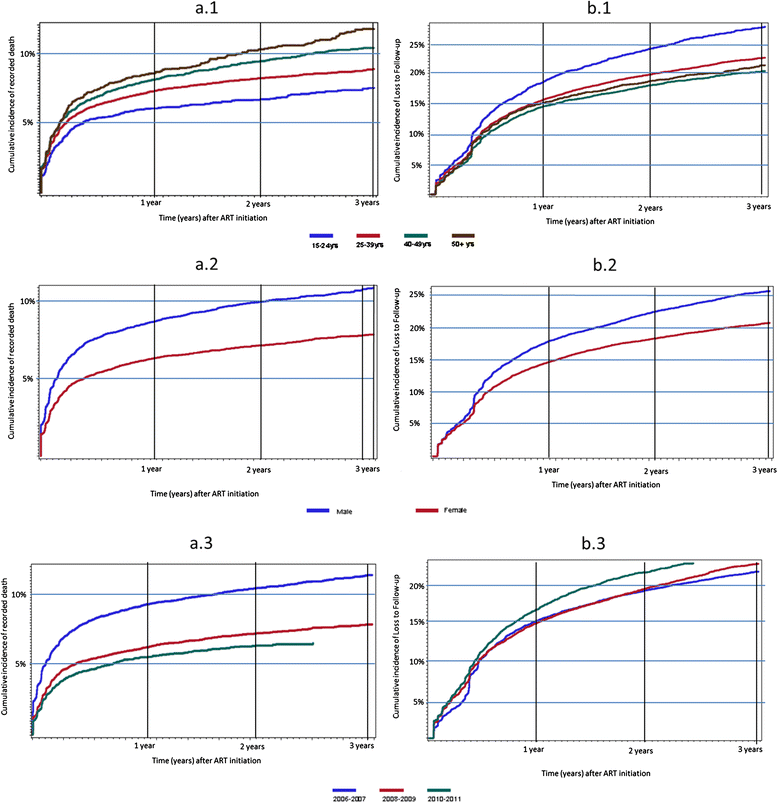Characteristics and outcomes of adult Ethiopian patients enrolled in HIV care and treatment: a multi-clinic observational study
- PMID: 25934178
- PMCID: PMC4455051
- DOI: 10.1186/s12889-015-1776-4
Characteristics and outcomes of adult Ethiopian patients enrolled in HIV care and treatment: a multi-clinic observational study
Abstract
Background: We describe trends in characteristics and outcomes among adults initiating HIV care and treatment in Ethiopia from 2006-2011.
Methods: We conducted a retrospective longitudinal analysis of HIV-positive adults (≥ 15 years) enrolling at 56 Ethiopian health facilities from 2006-2011. We investigated trends over time in the proportion enrolling through provider-initiated counseling and testing (PITC), baseline CD4+ cell counts and WHO stage. Additionally, we assessed outcomes (recorded death, loss to follow-up (LTF), transfer, and total attrition (recorded death plus LTF)) before and after ART initiation. Kaplan-Meier techniques estimated cumulative incidence of these outcomes through 36 months after ART initiation. Factors associated with LTF and death after ART initiation were estimated using Hazard Ratios accounting for within-clinic correlation.
Results: 93,418 adults enrolled into HIV care; 53,300 (57%) initiated ART. The proportion enrolled through PITC increased from 27.6% (2006-2007) to 44.8% (2010-2011) (p < .0001). Concurrently, median enrollment CD4+ cell count increased from 158 to 208 cells/mm(3) (p < .0001), and patients initiating ART with advanced WHO stage decreased from 56.6% (stage III) and 15.0% (IV) in 2006-2007 to 47.6% (stage III) and 8.5% (IV) in 2010-2011. Median CD4+ cell count at ART initiation remained stable over time. 24% of patients were LTF before ART initiation. Among those initiating ART, attrition was 30% after 36 months, with most occurring within the first 6 months. Recorded death after ART initiation was 6.4% and 9.2% at 6 and 36 months, respectively, and decreased over time. Younger age, male gender, never being married, no formal education, low CD4+ cell count, and advanced WHO stage were associated with increased LTF. Recorded death was lower among younger adults, females, married individuals, those with higher CD4+ cell counts and lower WHO stage at ART initiation.
Conclusions: Over time, enrollment in HIV care through outpatient PITC increased and patients enrolled into HIV care at earlier disease stages across all HIV testing points. However, median CD4+ cell count at ART initiation remained steady. Pre- and post-ART attrition (particularly in the first 6 months) have remained major challenges in ensuring prompt ART initiation and retention on ART.
Figures



Similar articles
-
Expansion and scale-up of HIV care and treatment services in four countries over ten years.PLoS One. 2020 Apr 16;15(4):e0231667. doi: 10.1371/journal.pone.0231667. eCollection 2020. PLoS One. 2020. PMID: 32298331 Free PMC article.
-
Trends in and correlates of CD4+ cell count at antiretroviral therapy initiation after changes in national ART guidelines in Rwanda.AIDS. 2015 Jan 2;29(1):67-76. doi: 10.1097/QAD.0000000000000520. AIDS. 2015. PMID: 25562492 Free PMC article.
-
Trends in clinical characteristics and outcomes of Pre-ART care at a large HIV clinic in Nairobi, Kenya: a retrospective cohort study.AIDS Res Ther. 2016 Nov 14;13:38. doi: 10.1186/s12981-016-0122-y. eCollection 2016. AIDS Res Ther. 2016. PMID: 27895697 Free PMC article.
-
How to Evolve the Response to the Global HIV Epidemic With New Metrics and Targets Based on Pre-Treatment CD4 Counts.Curr HIV/AIDS Rep. 2019 Aug;16(4):304-313. doi: 10.1007/s11904-019-00452-7. Curr HIV/AIDS Rep. 2019. PMID: 31278620 Free PMC article. Review.
-
Predictors of treatment interruption among patients on antiretroviral therapy in Akwa Ibom, Nigeria: outcomes after 12 months.AIDS Care. 2023 Jan;35(1):114-122. doi: 10.1080/09540121.2022.2093826. Epub 2022 Jun 28. AIDS Care. 2023. PMID: 35765160 Review.
Cited by
-
Virologic outcomes of people living with human immunodeficiency virus who started antiretroviral treatment on the same-day of diagnosis in Ethiopia: A multicenter observational study.PLoS One. 2021 Sep 3;16(9):e0257059. doi: 10.1371/journal.pone.0257059. eCollection 2021. PLoS One. 2021. PMID: 34478438 Free PMC article.
-
A Rapid Screening Program for Histoplasmosis, Tuberculosis, and Cryptococcosis Reduces Mortality in HIV Patients from Guatemala.J Fungi (Basel). 2021 Apr 1;7(4):268. doi: 10.3390/jof7040268. J Fungi (Basel). 2021. PMID: 33916153 Free PMC article.
-
Adherence to Antiretroviral Treatment Among People Who Started Treatment on the Same-Day of HIV Diagnosis in Ethiopia: A Multicenter Observational Study.HIV AIDS (Auckl). 2021 Nov 10;13:983-991. doi: 10.2147/HIV.S337073. eCollection 2021. HIV AIDS (Auckl). 2021. PMID: 34785956 Free PMC article.
-
Incidence and predictors of loss to follow-up among HIV infected adults after initiation of first line anti-retroviral therapy at University of Gondar comprehensive specialized Hospital Northwest Ethiopia, 2018: retrospective follow up study.BMC Res Notes. 2019 Feb 28;12(1):111. doi: 10.1186/s13104-019-4154-y. BMC Res Notes. 2019. PMID: 30819236 Free PMC article.
-
Retention in Care of Adult HIV Patients Initiating Antiretroviral Therapy in Tigray, Ethiopia: A Prospective Observational Cohort Study.PLoS One. 2015 Sep 4;10(9):e0136117. doi: 10.1371/journal.pone.0136117. eCollection 2015. PLoS One. 2015. PMID: 26340271 Free PMC article.
References
-
- Federal HIV/AIDS Prevention and Control Office [Ethiopia] Country Progress Report on HIV/AIDS Response: Federal Democratic Republic of Ethiopia. Addis Ababa, Ethiopia: Ethiopia Federal HIV/AIDS Prevention and Control Office; 2012.
-
- Central Statistical Agency [Ethiopia], ICF Macro . Ethiopia Demographic and Health Survey 2011. Addis Ababa, Ethiopia and Calverton, Maryland: Central Statistical Agency [Ethiopia]; ICF International; 2012.
-
- Berhane Y, Mariam DH, Kloos H. Epidemiology and Ecology of Health and Disease in Ethiopia. Addis Ababa, Ethiopia: Shama Books; 2006.
-
- WHO, UNICEF, UNAIDS . Global update on HIV treatment 2013: results, impacts, and opportunities. 2013.
Publication types
MeSH terms
Grants and funding
LinkOut - more resources
Full Text Sources
Other Literature Sources
Medical
Research Materials
Miscellaneous

